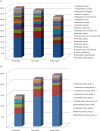Salivary bacterial fingerprints of established oral disease revealed by the Human Oral Microbe Identification using Next Generation Sequencing (HOMINGS) technique
- PMID: 26782357
- PMCID: PMC4717152
- DOI: 10.3402/jom.v8.30170
Salivary bacterial fingerprints of established oral disease revealed by the Human Oral Microbe Identification using Next Generation Sequencing (HOMINGS) technique
Abstract
Background and objective: The composition of the salivary microbiota, as determined using various molecular methods, has been reported to differentiate oral health from diseases. Thus, the purpose of this study was to utilize the newly developed molecular technique HOMINGS (Human Oral Microbe Identification using Next Generation Sequencing) for comparison of the salivary microbiota in patients with periodontitis, patients with dental caries, and orally healthy individuals. The hypothesis was that this method could add on to the existing knowledge on salivary bacterial profiles in oral health and disease.
Design: Stimulated saliva samples (n=30) were collected from 10 patients with untreated periodontitis, 10 patients with untreated dental caries, and 10 orally healthy individuals. Salivary microbiota was analyzed using HOMINGS and statistical analysis was performed using Kruskal-Wallis test with Benjamini-Hochberg's correction.
Results: From a total of 30 saliva samples, a mean number of probe targets of 205 (range 120-353) were identified, and a statistically significant higher mean number of targets was registered in samples from patients with periodontitis (mean 220, range 143-306) and dental caries (mean 221, range 165-353) as compared to orally healthy individuals (mean 174, range 120-260) (p=0.04 and p=0.04). Nine probe targets were identified with a different relative abundance between groups (p<0.05).
Conclusions: Cross-sectional comparison of salivary bacterial profiles by means of HOMINGS analysis showed that different salivary bacterial profiles were associated with oral health and disease. Future large-scale prospective studies are needed to evaluate if saliva-based screening for disease-associated oral bacterial profiles may be used for identification of patients at risk of acquiring periodontitis and dental caries.
Keywords: HOMINGS; dental caries; periodontitis; saliva.
Figures



References
-
- Jenkinson HF, Lamont RJ. Oral microbial communities in sickness and in health. Trends Microbiol. 2005;13:589–95. - PubMed
-
- Wade WG. The oral microbiome in health and disease. Pharmacol Res. 2013;69:137–43. - PubMed
-
- Pihlstrom BL, Michalowicz BS, Johnson NW. Periodontal diseases. Lancet. 2005;366:1809–20. - PubMed
-
- Takahashi N, Nyvad B. The role of bacteria in the caries process: ecological perspectives. J Dent Res. 2011;90:294–303. - PubMed
LinkOut - more resources
Full Text Sources
Other Literature Sources
Medical
